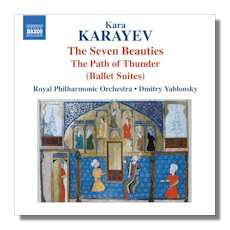
The Internet's Premier Classical Music Source
Related Links
- Latest Reviews
- More Reviews
-
By Composer
-
Collections
DVD & Blu-ray
Books
Concert Reviews
Articles/Interviews
Software
Audio
Search Amazon
Recommended Links
Site News
 CD Review
CD Review
Kara Karayev

Ballet Suites
- The Seven Beauties Ballet Suite
- Waltz
- Adagio
- The Dance of The Clowns
- The Seven Portraits
- Introduction
- The Indian Beauty
- The Byzantine Beauty
- The Khorezmian Beauty
- The Slavonic Beauty
- The Maghrebian Beauty
- The Chinese Beauty
- The Most Beautiful of The Beauties
- The Procession
- The Path of Thunder Ballet Suite
- General Dance
- The Dance of The Girls with Guitars
- The Dance of The Black Community
- Night in Stilleveld
- Scene and Duet
- Lullaby
- The Path Of Thunder (Finale)
Royal Philharmonic Orchestra/Dmitry Yablonsky
Naxos 8.573122 69m
Born in Baku, Azerbaijan, Kara Karayev (1918-1982) was a student and friend of Dmitri Shostakovich. While that older composer's influence is evident in these two ballet suites, it is his less serious side that we notice rather than the grim and dark music from the symphonies. Thus, it is the Shostakovich of the four Ballet Suites and some of the film scores that figure somewhat into these two ballet suites. Having said this, many listeners will likely associate the music here as much with Khachaturian as with Shostakovich, owing to its exoticism and consistent lightness. In spirit it shares much with Khachaturian's ballets Gayaneh and Spartacus.
The Seven Beauties dates from 1953 and offers many catchy tunes: try the opening Waltz or The Indian Beauty (No. 5) or The Most Beautiful of The Beauties (No. 11). Actually, there are times when the music can turn a little grotesque, as in The Dance of The Clowns (No. 3), and there are instances too (The Maghrebian Beauty – #9) when the music can sound reminiscent of the some of the more exotic Hollywood swashbuckler scores of the 1950s, replete with splashy orchestration, exotic love music, and catchy rhythms. If you like light, colorful music, you won't find a dull moment in this score.
The Path of Thunder is quite similar, but with a tad more of an edge and a little more substance. Although it was dedicated to the memory of Prokofiev, it sounds very little like his music. General Dance (No. 1) features infectious rhythms and deft orchestration, and about midway through a humorous sort of Stravinskyan passage of deliberately sour notes. Speaking of infectious rhythms, Dance of the Girls with Guitars (No. 2) brings on much foot-tapping spirit and a dreamy sense of the exotic. The ensuing number, The Dance of the Black Community offers some attractive rhythms from percussion, while the longest selection in either ballet suite here, Scene and Duet (No. 5 – nearly ten minutes), features some lovely melodies, perhaps the most memorable themes on the disc. The concluding number, The Path of Thunder (No. 7), begins in a sinister manner with the piano, percussion and winds auguring menace in their mysterious and agitated buildup. The music eventually reaches a Ravelian sort of brassy climax that goes on and on, as if the composer wants to let the thunder ring out.
The Royal Philharmonic Orchestra plays splendidly and spiritedly for Dmitry Yablonsky who seems to have the full measure of these scores. The sound reproduction from Naxos is excellent. If you're interested in the lighter side of ballet music, this disc will likely be a pleasing addition to your collection.
Copyright © 2014, Robert Cummings





















